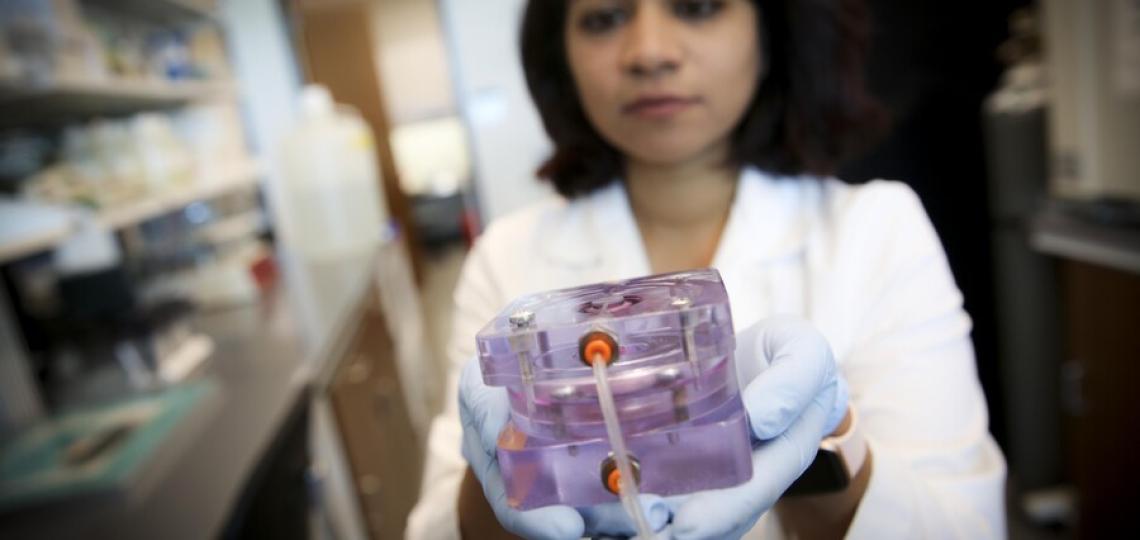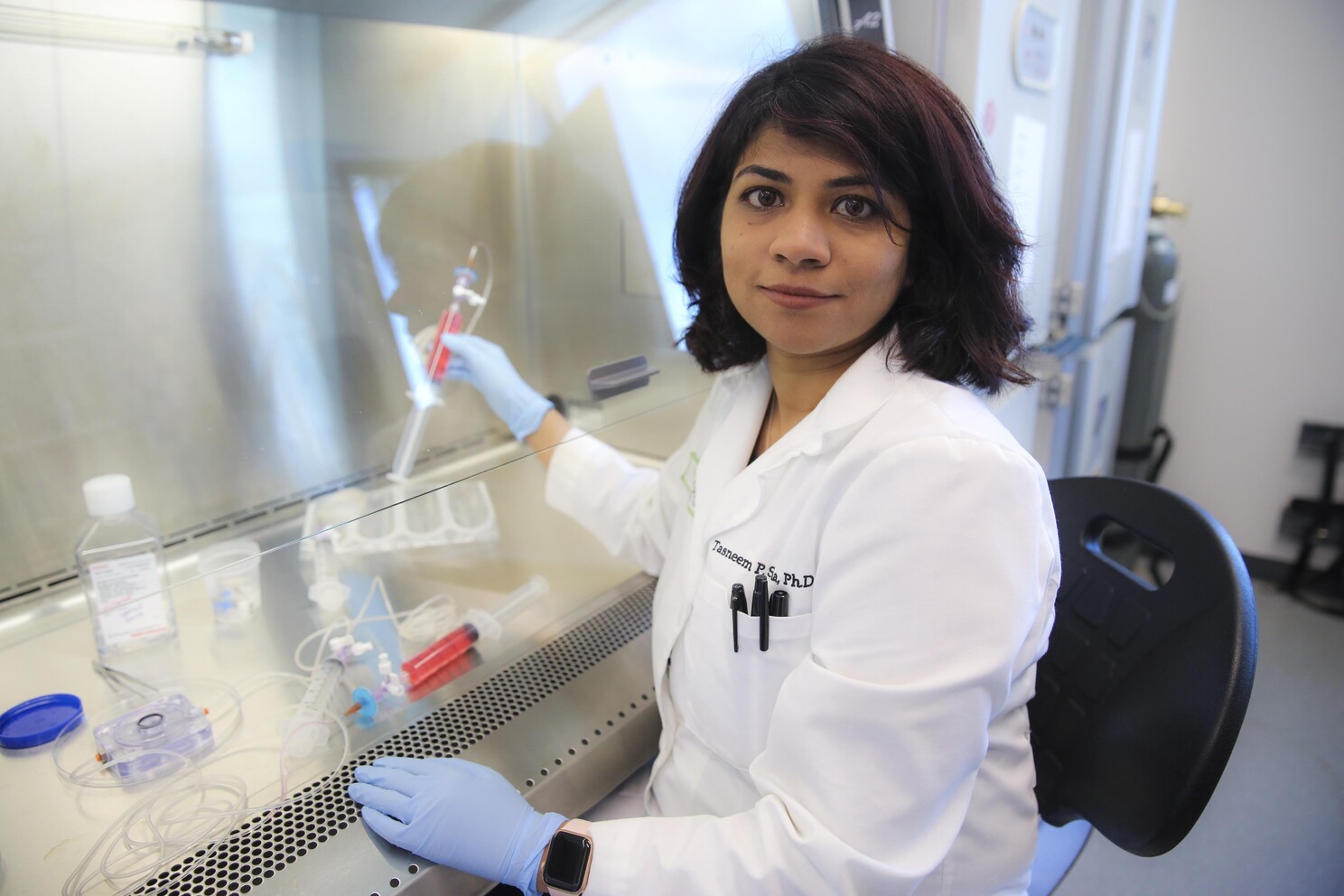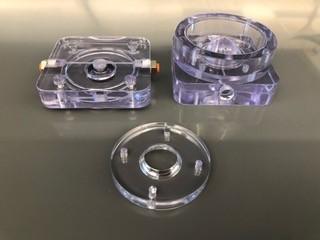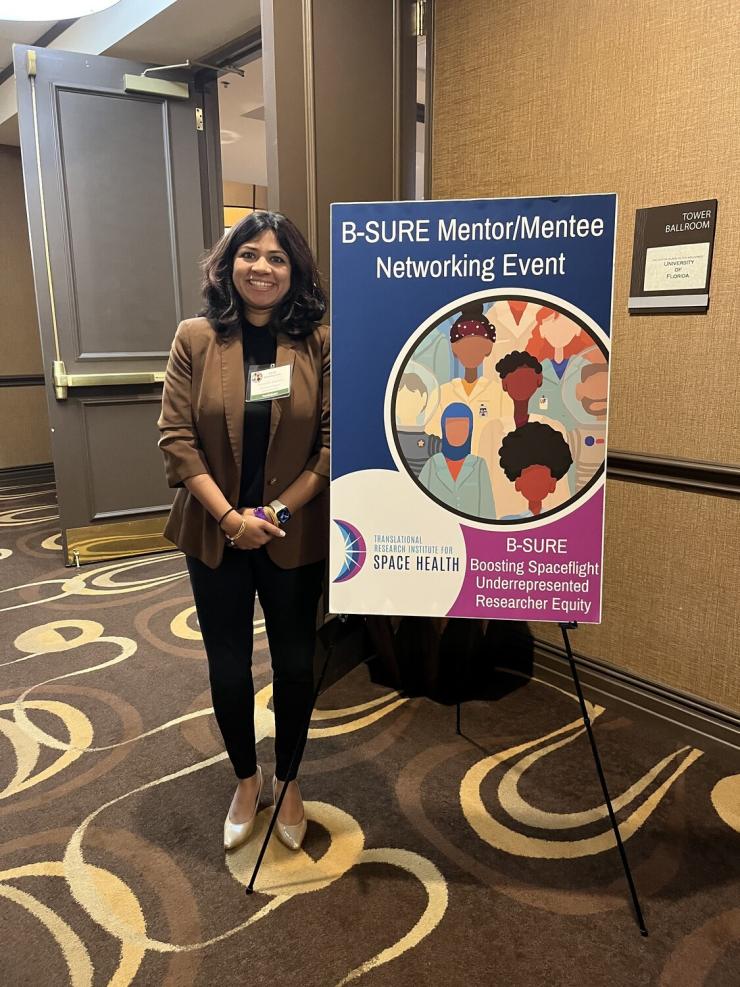
Human Vision: Far and Beyond

Dr. Tasneem Sharma
TRISH Investigator
B-SURE Participant

Vision is a fundamental sense of the human body. Without sight, the quality of life of a person can significantly change. Losing the ability to see at any stage of a person’s life can be immensely debilitating but it becomes more detrimental when it is lost at a young age.
“We can only see a short distance ahead, but we can see plenty there that needs to be done.” ― Alan Turing.
This quote has always moved me as a researcher and innovator. However, the big question is what drove me to become a scientist.
Family support is a big driver for success and plays a huge formative role in the goals you pursue. I have been blessed by numerous facets of support; my family, my friends, my mentors and all the people who have influenced me as I have traversed my journey of life. As everyone says, “it takes a village to raise a child” which was very true in my case. My family has shaped who I have become today. My parents have been always my guiding light, boosting my confidence at every stage of my career. My sister was and will always be my partner in crime through every struggle. I cannot say enough about my husband, who everyone around me and myself just describes as a “keeper”. Through grant cycles, deadlines and numerous ups and downs of my scientific career, he never leaves my side, sometimes sitting on a couch, watching a Netflix show on mute, keeping me company in silence, as I feverishly write away, lost in my realm of science. And my kids are just the bolt of energy that I need to recharge at the end of every day.
The question I always ask myself is “why”. Why join a field which sometimes may feel thankless yet fulfilling? Why strive to keep writing grants when rejection rates are almost at ninety percent? How do I generate therapies to improve public health? It is my curiosity that keeps me going. When I am still writing a grant at 4am, my will to develop treatments keeps me going. It is my passion to develop a cure to overcome blindness.
I am fortunate to have vision and I did not realize the importance of the scientific work every vision researcher is doing until my postdoctoral position in Dr. Budd Tucker’s lab. His lab is an inherited retinal eye disease lab that specializes in stem cell technologies and gene therapy. My project in his lab was on a gene, which at the time was associated with only 27 documented patients worldwide. A mutation in this gene caused early or childhood onset retinitis pigmentosa, a visual disorder characterized by progressive death of the light-sensing photoreceptor cells of the outer neural retina. There is currently no cure for the disease with only a possibility that a future gene therapy could help young patients. Watching children come through the lab with various forms of inherited retinal disorders was both heartbreaking and a driver for therapeutic development to save sight.
My postdoctoral work was an eye opener to finding effective strategies for treating visual disorders. One of the biggest hurdles in drug discovery is efficient human model systems that can effectively mimic the human disease. It gave rise to my passion of having a human model system to test retinal therapeutics that targets every patient individually. My ultimate vision is increase accessibility to human systems to test drugs. To increase access, new potential drugs need efficient testing in human model systems. Most drugs have high failure rates in clinical trials due to testing only in animal models and the lack of testing in effective preclinical human models.
I was interested in ways to develop better tools to study ocular pressure, using human donor eyes to study human disease development and promoting survival of retinal neurons. My goal was to use my training in stem cell derived neuronal models to address this shortcoming and provide personalized models to test therapies and recapitulate human retinal disease. This includes glaucoma, a multifactorial disease of the terminal retinal neurons, that causes blindness in early childhood patients with known glaucoma mutations or mainly elderly patients with high eye pressures. Recognizing the critical need for a pressurized human eye model to study retinal therapeutics, I invented a preclinical translaminar autonomous system to model human ocular pressure. The model provided an opportunity to keep the human retina alive over long periods and truly mimic human retinal neurodegeneration in response to pressure changes.
However, this journey was not easy. This is where my village came together. I truly believe in the philosophy of perseverance and empowerment. As I reminiscence about my career path to date, I feel this has always been true for me. The development of the “Translaminar Autonomous System” model was because I persevered and was empowered by a supportive mentor, Dr. Colleen McDowell, and a thriving intellectual environment to innovate it.
Success, though, isn’t possible without the countless heartaches and striving to achieve better. In the beginning, my system was just a drawing on paper.

I said to myself, “If we can keep the front of the eye alive in culture, why is it not possible with the back of the eye?” We need to have human retinal neurons alive in culture to study therapies in a pre-clinical human system. With no expertise in engineering but the strong will to persevere, I sought help from family and reached out to my mechanical engineer cousin, Husain Lohawala.
Husain and I brainstormed for weeks before we came up with our first prototype.
However, it only allowed culture of the eye but no automation with fluid systems to keep the eye alive for long periods. I turned to my husband, Gaurav Sharma, a Software Engineer, and an accomplice by marriage. I requested his assistance and said the work could go no further without his expertise. With his help we proceeded to build numerous prototypes. It wasn’t successful each time, but we did learn from each prototype. We would build a prototype and have successful functionality in certain aspects but not in others. So ensued multiple brainstorming sessions with my mentor and the team. And finally, we had a successful model in our hands.
The first-ever device for maintaining the human posterior eye under pressure, which could revolutionize clinical therapy testing.
With a utilities patent underway, it was a phone call from Dr. Emmanuel Urquieta at the Translational Research Institute for Space Health (TRISH) that started my journey in the field of space biology. His simple question about whether I was interested in submitting a proposal for a grant solicitation from TRISH changed my research trajectory. He was intrigued about my novel model, and inquired if it could be utilized for Spaceflight-associated Neuro-ocular Syndrome (SANS).
This syndrome of ocular clinical findings is seen in astronauts after six months or more of long-term missions. Amongst other visual changes, the astronauts become increasingly hyperopic (long-sighted) over time which essentially requires dynamically changing reading glasses. This may not seem significant in short missions but could become mission critical during long duration Artemis or Mars missions, which makes it a high risk for NASA.
I was interested and amazed how this idea for pursuing space research and SANS just fell into my lap. Submitting a TRISH proposal was a high-risk idea, but I was enthralled, eager to commit, and excited to acquire funding to characterize my model for SANS. I immediately spent the next two weeks reading and writing a grant proposal for TRISH to use my model as a ground analog for SANS. After many sleepless nights, six weeks later, I found out that I had received funding for my first-ever extramural grant from TRISH. I was on the way to exploring new frontiers.
I and my research team spent the next six months purchasing all the supplies, reagents, and equipment for the project, and were on the cusp of starting our large-scale study, when suddenly COVID-19 was declared a pandemic. Everything we had worked for came crashing down. We had to immediately shut down the labs, the experiments were closed out, and all the human eye samples were discarded in just a span of one week. It was devastating to have spent so much time and effort for everything to be put on pause, but our lab shutting down seemed inconsequential compared to the immense tragedy that engulfed the lives of everyone who was suffering from COVID or loved ones who passed due to the virus.
With an eye on adaptation, we changed gears and brainstormed new ways of completing the milestones we intended to set out to ensure that we were truly doing justice to the initial proposal. The silver lining from the pandemic was and has been the ability to adapt and accept change, while still moving forward.
In the meantime, my professional career was also taking a turn. I had been offered a position at Indiana University as an assistant professor. I was in the middle of a pandemic, 7 months pregnant with my second baby, and starting a new position in Indiana. I was leaving my family support in Texas to start a new life in a new state with my growing family. The TRISH grant amidst all these changes was a blessing in disguise. There were a lot of opportunities coming my way and I was at the right place at the right time. I realize that my current faculty position is in part because of TRISH and the doors it opened for me. Under the directorship of Dorit Donoviel, PhD, TRISH has steered toward novel high-risk projects and discoveries that surpass normal NASA priorities, ensuring TRISH awardees keep innovating. TRISH did not just provide me with a grant but has since supported educational as well as mentorship programs, encouraged current and previously funded investigators such as myself at numerous events and platforms, boosting our confidence, giving us a stage to speak on, and encouraging our drive.
After I received my grant, I had numerous offers for faculty positions from multiple institutions. It was truly an embarrassment of riches. However, Indiana University stood out to me the most. The collegial and collaborative environment, including the perfect rapport between basic scientists and clinicians, is what drew me to Indiana. I knew the horizons of research that I was trying to explore were nearer and more so because my ultimate goal has always been translational research. The core of any basic biomedical science research is to eventually translate it to clinical research. My model and training in stem cell technology gives me the opportunity to test therapies with a focus on precision medicine that encompasses all diversity of individuals.
My educational experience and career have been a whirlwind from having grown up in multiple countries and having diverse cultural exposure. I am a woman and have deep ethnic roots. My dad is Indian, and my mom is Tanzanian. Their multicultural background allowed me to appreciate diversity and its impact on how you view the world. Through my childhood experiences, I learned that life is not confined to boundaries of wealth, culture, or ethnicity. These experiences have translated into my career in many ways, from my research focusing on neurodegenerative diseases - where the role of race/ethnicity is critical to understanding disease development - to my lifelong interest in mentoring young women and students traditionally underrepresented in science.
I’m grateful I had the opportunity to have a village and experience meaningful mentorships throughout my career to sustain my vision to help people. From my Ph.D. mentor, Dr. Abbot Clark, whose passion for glaucoma is never-ending, to my first postdoctoral mentor, Dr. Budd Tucker, whose drive for saving vision is relentless. And I cannot say enough about Dr. Colleen McDowell, my second postdoctoral mentor. Without her support, compassion and belief in me, the Translaminar Autonomous System would have not been born. I was lucky and blessed to have these mentors in my life. They helped me when I needed it. They believed in me when I did not believe in myself. They pushed me when I had given up hope, not ever leaving my side. Even to this day, they are the helping hand when I need it. Their mentorship is what drives and inspires me to be a better mentor.
Even as a faculty member, I feel that without mentorship, I would be lost. At Indiana University, I have been given a similar mentorship support system, with Drs. Tim Corson, Yoshikazu Imanishi, Kathryn Haider, and Alex Robling. Their support has been endless, and they ensure that every grant I submit, every career move I make and every important decision I enquire about helps my career trajectory. Their support encouraged me to apply for the Boosting Spaceflight Underrepresented Research Equality (B-SURE) program, supported by TRISH which pairs NASA research mentors with under-represented mentees like me.
The B-SURE program assist mentees to apply for space health research funding through various NASA solicitations. The program not only encourages our applications but downstream, provides guidance on grantsmanship and reviews.
The B-SURE program has transformed my outlook and perspective on how to get immersed in the NASA human research program and space biology field. This program, implemented by Drs. Rachael Seidler, Ana Diaz Artiles, Josephine Allen and Christine Wegner, is truly transformative. The experience has been invaluable, from the Foundations of Funding Workshop they organized, to giving mentees financial support to attend conferences such as the NASA Human Research Program Investigator’s workshop in Galveston.

Attending these workshops and conferences were eye-opening as I learned about NASA’s mission directorate priorities and had the opportunity to truly understand what NASA needs from our grant applications. The grant funding workshop allowed me to network and make connections with instrumental investigators from the NASA realm. It included collaborations in the radiation spectrum with Dr. Xiao Wen Mao and connecting with Dr. Dan Buckland, who was influential in giving me the opportunity to present in front of the NASA Human System Risk Board. He also provided other opportunities, which included connecting me with Dr. Tyson Brunstetter, the operational risk custodian for the SANS risk. Attending the NASA HRP IWS conference as a B-SURE mentee and TRISH awardee gave me the exposure and substance to elicit other collaborative efforts (Lunar Rover Zebro), which I would have never otherwise sought, as well as the opportunity to speak with commercial spaceflight companies such as Axiom Space and SpaceX. My village of B-SURE mentors came through for me and it is a key reason I feel I was selected for the Step 2 NASA HRP Human Exploration Research Omnibus Opportunity to study SANS.
As we travel to the Moon, Mars, and beyond, we need to understand the consequences of long duration spaceflights and missions. Prolonged exposure to microgravity can disrupt the body’s natural mechanisms. Our model will address not only a major knowledge gap by simulating spaceflight stressors in human eye models but can be extended for other earthbound challenges like radiation oncology and nuclear radiation exposure. Even though these goals seem daunting, they seem attainable because I have my village. My support system helps me as I navigate the unknown and explore the possibility of life beyond earth.








